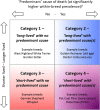Longevity and mortality in Kennel Club registered dog breeds in the UK in 2014
- PMID: 30349728
- PMCID: PMC6191922
- DOI: 10.1186/s40575-018-0066-8
Longevity and mortality in Kennel Club registered dog breeds in the UK in 2014
Abstract
Background: The domestic dog is one of the most diverse mammalian species, exhibiting wide variations in morphology, behaviour and morbidity across breeds. Therefore, it is not unexpected that breeds should also exhibit variation in mortality and longevity. While shorter longevity per se may not necessarily be a welfare issue, a generally foreshortened lifespan in a breed that is accompanied by a high prevalence of a particular cause of death may reveal potentially serious welfare concerns and highlight scope to improve breed welfare. Survey data gathered directly from owners offer useful insights into canine longevity and mortality that can support the overall evidence base for welfare reforms within breeds.
Results: Mortality data on 5663 deceased dogs registered with the UK Kennel Club were collected from an owner-based survey. The most commonly reported causes of death were old age (13.8%), unspecified cancer (8.7%) and heart failure (4.9%); with 5.1% of deaths reported as unknown cause. Overall median age at death was 10.33 years (interquartile range: 7.17-12.83 years). Breeds varied widely in median longevity overall from the West Highland Terrier (12.71 years) to the Dobermann Pinscher (7.67 years). There was also wide variation in the prevalence of some common causes of death among breeds, and in median longevity across the causes of death.
Conclusion: Substantial variation in the median lifespan and the prominent causes of death exists across breeds. This study has identified some breeds with both a low median lifespan and also a high proportional mortality for one or more specific causes of death that should be considered as both potential welfare concerns as well as opportunities for improvement.
Keywords: Death; Healthspan; Lifespan; Longevity; Mortality; Pedigree; Predisposition; Purebred.
Conflict of interest statement
Participants consented to the data provided on dogs being used for the purposes of research according to the Kennel Club’s Privacy policy: http://www.thekennelclub.org.uk/privacy-policy/?utm_campaign=PBHS+EMAIL++Single+dog+owners&utm_source=emailCampaign&utm_medium=email&utm_content= Not applicable.KE and TL are employed by the Kennel Club. BW and AL-Z were employed by the Kennel Club and KE was employed by the University of Nottingham School of Veterinary Medicine and Science at the time the study was undertaken. DON was funded at the RVC by an award from the Kennel Club Charitable Trust.Springer Nature remains neutral with regard to jurisdictional claims in published maps and institutional affiliations.
Figures





References
-
- Wayne RK, Leonard JA, Vila C. Genetic analysis of dog domestication. In: Zeder MA, editor. Documenting domestication: new genetic and archaeological paradigms. Berkeley, California: University of California Press; 2006. pp. 279–293.
-
- Vaysse Amaury, Ratnakumar Abhirami, Derrien Thomas, Axelsson Erik, Rosengren Pielberg Gerli, Sigurdsson Snaevar, Fall Tove, Seppälä Eija H., Hansen Mark S. T., Lawley Cindy T., Karlsson Elinor K., Bannasch Danika, Vilà Carles, Lohi Hannes, Galibert Francis, Fredholm Merete, Häggström Jens, Hedhammar Åke, André Catherine, Lindblad-Toh Kerstin, Hitte Christophe, Webster Matthew T. Identification of Genomic Regions Associated with Phenotypic Variation between Dog Breeds using Selection Mapping. PLoS Genetics. 2011;7(10):e1002316. doi: 10.1371/journal.pgen.1002316. - DOI - PMC - PubMed
-
- Gough A, Thomas A, O'Neill D. Breed predispositions to disease in dogs and cats. 3. Chichester, West Sussex: Wiley-Blackwell; 2018. p. 398.
LinkOut - more resources
Full Text Sources

